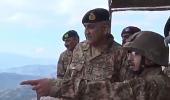The DGCA official who wrongly assigned the code of Antonov AN-32 -- an aircraft used by the IAF -- to the SpiceJet aircraft has been suspended, report Arindam Majumder and Aneesh Phadnis.

On the morning of August 30, air traffic controllers at Lahore were startled to find that an 'Indian military aircraft' had entered the Pakistan airspace.
They were confused, too, as according to the flight plan and identification by the pilot, it was a civilian Boeing 737 plane but was transmitting the code of a military aircraft.
They asked the pilot to hold the aircraft and alerted the Pakistan Air Force, which sent two F-16 fighter jets to escort it for about half an hour till it exited the country's air space.
As things turned out, it was actually a SpiceJet flight with 120 passengers on board heading to Kabul from Delhi.
The reason for the mistaken identity was a clerical error by an official of India's aviation regulator, which assigned a military code while registering the SpiceJet aircraft.
The unprecedented situation, barely a month after Pakistan had reopened its airspace post-Balakot air strike tension, prompted the Prime Minister's Office to step in.
Soon after, an official of the Directorate General of Civil Aviation (DGCA) was suspended.
In a warm gesture, civil aviation secretary Pradeep Singh Kharola thanked his Pakistani counterpart Sharukh Nusrat for handling the situation calmly.
That done, the incident has forced DGCA to speed up its work on digitising the aircraft records. The regulator recently selected Tata Consultancy Services (TCS) for the process.
Sources aware of the development said SpiceJet had approached DGCA early August for registration of the aircraft which was earlier with Jet Airways.
According to International Civil Aviation Organisation (ICAO) norms, while registering an aircraft, aviation regulators all over the world assign a unique 24-digit code called Mode-S -- a digitised identification number.
The alpha-numeric code is relayed by a transponder that can be identified by advance radar surveillance system in order to improve air navigation system and stop airspace incursions.
DGCA, however, creates a pool of such codes and allots a certain number to each airline. When airlines approach DGCA for registering a new aircraft, the regulator checks its air worthiness and assigns a code.
Sources said in this manual process, the concerned DGCA official wrongly assigned the SpiceJet aircraft a code of Antonov AN-32 -- an aircraft used by the Indian Air Force.
"In those days, work was hectic. SpiceJet was adding at least two to three aircraft daily in its fleet. The error crept in and no one took notice," said a government official.
Following the closure of Jet Airways, SpiceJet added 22 aircraft of Jet in two months.
The aircraft operated with the military code for almost 20 days and also operated to international destinations like Colombo and Bangkok. But no one took note until it went into Pakistani air space.
"Incorrect or missing Mode-S code, whether caused by individual equipment malfunctions or human input error, may prevent aircraft from being presented on air traffic controller surveillance displays and, and result in potentially hazardous situations," a direction by European Union Aviation Safety Agency says.
A senior official of India's air navigation authorities defended the oversight, saying that normally air traffic controllers work on primary and secondary radar systems, which give details of height, speed and altitude, among others.
"Only when there is a heightened surveillance, secondary surveillance radar system is used to track the Mode-S code. Pakistani airspace must be using it for Indian aircraft due to the current situation," the official said.
Sources said the Lahore air traffic control acted maturely and asked the pilot to hold the aircraft and informed the Air Force.
"PAF then sent the fighter jets in order to verify the aircraft. The pilot, who has 12 years of experience, didn’t panic and complied with the direction from the ATC," the person said.
In 1988, a United States warship had shot down an Iranian aircraft after it had mistaken it as a military aircraft, killing all 290 passengers on board.
Following the incident, DGCA has automated the process of issuing codes to aircraft.
"We have cross checked all codes assigned to ensure there is no such cases of duplication. A lesson has been learnt," a senior DGCA official said.












 © 2025
© 2025